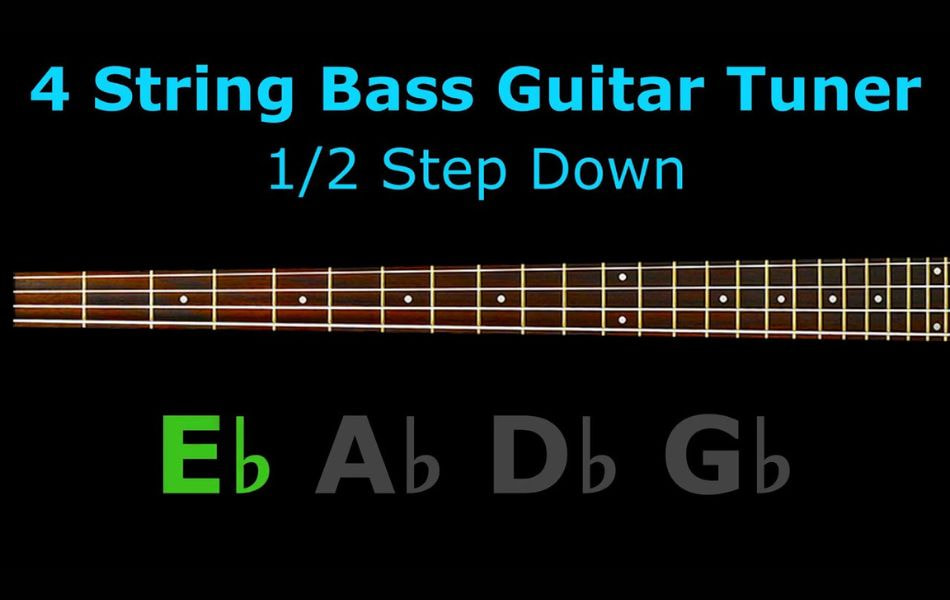How To Master Half-Step Down Bass Tuning
One such tuning worth delving into is lowering half-step down bass tuning. It's a simple adjustment that can bring a new dimension to your playing, offering a fresh range of tones and styles. In this guide, we'll walk you through the process, making it easy for you to unlock the potential of this tuning.
What is half-step down bass tuning
Notes in half-step down
To comprehend the significance of half-step down bass tuning, having a fundamental grasp of musical intervals, which represent the space between two musical notes, is essential.
In a musical scale, various intervals can be identified, with the half-step being the smallest possible interval. On a guitar, a half-step is equivalent to moving one fret higher or lower. This holds true even in cases where there are no sharps or flats, like transitioning from B to C or E to F; both represent a half-step or a minor-second interval.
When tuning all your strings down by a half-step, you are effectively shifting all the notes in standard tuning to a lower pitch, precisely by a half-step or one fret. This adjustment can be accurately achieved using a guitar tuner.
In the standard tuning, which serves as the common starting point for most guitarists, the notes undergo the following changes when tuning down a half-step. Please note that this list starts from the thin, high E-string and proceeds to the thick, low E-string.
- E → E♭/D♯
- B → B♭/A♯
- G → G♭/F♯
- D → D♭/C♯
- A → A♭/G♯
- E → E♭/D♯

Concept of half-step down bass tuning
When musicians talk about a specific tuning being in "half-step down," they are essentially referring to a set of notes: E♭, B♭, G♭, D♭, A♭, and E♭. These notes are obtained by lowering the pitch from the standard tuning, hence it's also commonly known as E♭ tuning. Interestingly, you could further lower these pitches by another half-step, although this tuning wouldn't be termed as "half-step down."
In contrast, the tuning D, A, F, C, G, and D is popularly recognized as "whole step down." This is because it involves a full step decrease from the standard tuning pitches you likely already use and are familiar with. The distinctiveness of these tunings adds a layer of versatility and creativity to the musical repertoire.
Why use half-step down bass tuning
Utilizing a half-step down tuning on the bass guitar provides a captivating tonal depth and warmth. Lowering the pitch by a half-step gives the notes a richer, mellow quality. This alteration is particularly beneficial for genres that demand a deeper and more resonant sound.
The lower tonal range achieved through half-step down tuning is often associated with genres like blues, jazz, or rock, enhancing the overall expressiveness of the music.
Adjusting the tuning of a bass guitar down by a half-step can enhance playability and comfort for the musician. The strings become slightly looser, making it easier to fret and maneuver across the fretboard.
This can be especially advantageous for players with smaller hands or those seeking a more relaxed feel during extended playing sessions. The reduced tension allows for smoother transitions between notes and chords, ultimately contributing to a more enjoyable and fluid playing experience.
Individuals often retain their existing strings and appreciate the diminished tension as it permits them to slightly lower the tuning without requiring a fresh guitar arrangement. Many individuals are fond of drop D tuning for the same rationale.

Some famous half-step down bass tuning
There is no finite or specific number of half-step down tunings for bass guitar, as tunings can vary based on the preference of the player and the musical context. Half-step down tuning involves lowering each string on the bass guitar by one half-step (or one semitone) compared to standard tuning. However, some common half-step down bass tuning include Eb Standard tuning and D# Standard tuning.
In Eb Standard tuning, each string is tuned to the following notes (from thickest string to thinnest): Eb, Ab, Db, Gb, Bb, and Eb. Whereas, D# Standard tuning, each string is tuned to the following notes (from thickest string to thinnest): D#, G#, C#, F#, A#, and D#.
Both tunings achieve the same pitch intervals, but the choice of notation depends on the context and the preference of the player or musician. Musically, these tunings are identical, and the selection of which to use depends on the musical notation conventions or personal preference.
Hopefully, this guide has provided clear instructions on achieving half-step down bass tuning. It allows you to explore a new sonic palette and open up exciting musical possibilities. Just like half-step down tuning, there are other popular bass guitar tunings like drop D, full-step down, and drop C that you should definitely consider exploring.







